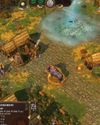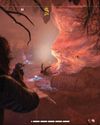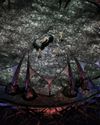PC Gamer talks to ELITE DANGEROUS creator David Braben about the way Frontier’s simulated galaxy reflects our own.

In February 2017, NASA announced that the TRAPPIST-1 system – located a mere 229 trillion miles from Earth – contains seven terrestrial planets, three of which are in the so-called Goldilocks zone. Almost 4,000 exoplanets have been detected by astronomers to date, but the large number of Earth-sized planets in this particular system makes the discovery special.
And when I heard about it, my immediate thought was: I want to go there in Elite Dangerous. Frontier has reacted to real-world astronomy discoveries before in its realistic simulation – including updating Pluto to reflect the stunning images taken by the New Horizons probe – and I wondered if TRAPPIST-1 would receive similar treatment. I was delighted to discover that it would.
The system is now in the game waiting to be visited. The perfect excuse to take my Cobra for a spin and do some space tourism, and also to talk to Elite creator and Frontier founder David Braben about the system and its inclusion in the game’s simulated galaxy.
“The tool we use to generate our Milky Way is called Stellar Forge, and it’s evolved from what was in Frontier long ago in terms of predicting how the galaxy works,” he says. “Beyond about 40-45 light years, even Hubble can’t see M-class red dwarf stars. They’re tiny and quite faint, and that’s what TRAPPIST-1 is. It’s right on the edge of what can be seen, even with the best telescopes.”
هذه القصة مأخوذة من طبعة June 2017 من PC Gamer.
ابدأ النسخة التجريبية المجانية من Magzter GOLD لمدة 7 أيام للوصول إلى آلاف القصص المتميزة المنسقة وأكثر من 9,000 مجلة وصحيفة.
بالفعل مشترك ? تسجيل الدخول
هذه القصة مأخوذة من طبعة June 2017 من PC Gamer.
ابدأ النسخة التجريبية المجانية من Magzter GOLD لمدة 7 أيام للوصول إلى آلاف القصص المتميزة المنسقة وأكثر من 9,000 مجلة وصحيفة.
بالفعل مشترك? تسجيل الدخول

A New Dawn - The rise, fall and rise again of PC Gaming in Japan
The so-called 'Paso Kon' market (ie katakana's transliteration of 'Pasonaru Computa') in Japan was originally spearheaded in the 1980s by NEC's PC-8800 and, later, its PC-9800.

MARVEL: ULTIMATE ALLIANCE
Enter the multiverse of modness.

SLIDES RULE
Redeeming a hated puzzle mechanic with SLIDER

GODS AND MONSTERS
AGE OF MYTHOLOGY: RETOLD modernises a classic RTS with care

PHANTOM BLADE ZERO
Less Sekiro, more Wo Long: Fallen Dynasty

STARR-MAKING ROLE
Final Fantasy XVI's BEN STARR talks becoming a meme and dating summons

THIEF GOLD
Learning to forgive myself for knocking out every single guard.

HANDHELD GAMING PCs
In lieu of more powerful processors, handhelds are getting weirder

FAR FAR AWAY
STAR WARS OUTLAWS succeeds at the little things, but not much else shines

FINDING IMMORTALITY
Twenty-five years on, PLANESCAPE: TORMENT is still one of the most talked-about RPGs of all time. This is the story of how it was created as a ‘stay-busy’ project by a small team at Black Isle Studios